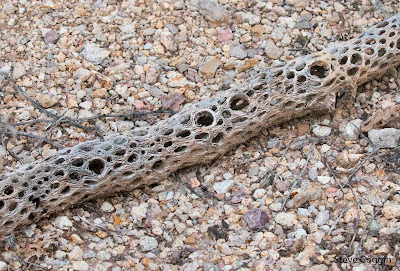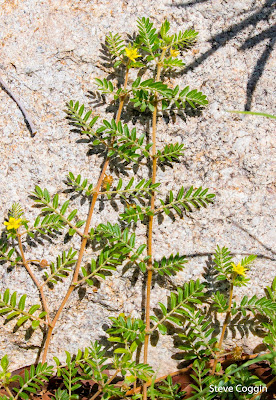 |
| Sonoaran Desert in the dry season. Saguaro and other desert plants show the effect of the lack on rain. Coronado National Forest, Arizona. |
 |
| Sonoran Desert with a profusion of wildflowers including Arizona Poppy (Kallstroemia grandiflora). Coronado National Forest, Arizona. |
In August, Diane and I visited the Sonoran and Chihuahuan deserts of Arizona. When we told friends of our plans they looked at us like we were crazy. They viewed going to the desert in August as bordering on reckless. But late summer in Arizona is the monsoon season. Moist air streams north from the Pacific and Gulf of Mexico to drop over one third of the annual rainfall for the year during the summer months. This rain causes a profusion of annual plants to germinate, flower and go to seed. Perennial plants also flower with the summer abundance of water.
 |
| Saguaros with arms, Ocotillo and Prickly Pear (Opuntia sp.) Saguaro National Park, Arizona. |
The Sonoran Desert is characterized by the iconic Saguaro Cactus (Carnegiea gigantea). These giants reach heights of over 50 feet and may live hundreds of years. A whole suite of other desert plants live among the Saguaros like Ocotillo, Acacias and many herbs. Desert plants often have spines to protect themselves and the water they contain from grazing animals. Saguaros have vertical rows of spines and the trunk is pleated. During dry times the circumference of the cactus decreases and pleats fold in. When the rains come, the shallow root system takes up large amounts of water, the circumference increases and the pleats expand.
 |
| A towering Saguaro cactus showing its pleats and rows of spines. Saguaro National Park, Arizona. |
 |
| Saguaro in flower with pollenating bees. Saguaro National Park, Arizona. |
 |
| Cactus Wrens (Campylorhyncus brunneicapillus) on top of a Saguaro. These small birds live and nest on cacti, as their name suggests. Maricopa County, Arizona. |
The Chihuahuan Desert lies east of the Sonoran Desert and ranges from southeastern Arizona, southern New Mexico, west Texas and into the state of Chihuahua, Mexico. This desert is generally at a higher altitude than the Sonoran Desert, with extensive grasslands and characteristic yuccas and agaves.
 |
| Grassland in the transition zone between the Sonoaran and Chichuahuan Deserts. This area was flush with green grass. Las Cienegas National Conservation Area, Arizona. |
Yuccas and agaves are found throughout these deserts. They are classified in the Asparagaceae along with that delicious food plant, asparagus. They have long leaves with spines along the leaf margins and a large spine on the tip. Yuccas can flower many times but agaves flower once then die. Agave americana, the Century Plant, is a native to the deserts of the American southwest and northern Mexico. These plants can live for 20-30 years (not 100) and are the starting material for the alcoholic beverage mescal. A related species, A. tequilana, is used to make tequila. The last act in the life of a Century Plant is to send up a 30 foot flowering stalk with dozens of yellow flowers. These flowers are pollinated by bats, moths and hummingbirds.
 |
| Century Plant flowers. Saguaro National Park. |
 |
| Brown-spined Prickly Pear (Opuntia phaeacantha) in flower. Coronado National Forest, Arizona. |
 |
| Pincushion Cactus (Mammillaria grahamii) in flower. Coronado National Forest, Arizona. |
 |
| Tree Chollo (Cylindropuntia imbricata) in flower. Saguaro National Park, Arizona. |
 |
| Wooden "skeleton" of Tree Chollo. The skeleton is the internal bracing that supports the plant. Saguaro National Park, Arizona. |
 |
| Ocotillo (Fouquieria splendens) branch with leaves. For much of the year Ocotillo looks like dead sticks. Saguaro National Park, Arizona. |
 |
| Ocotillo with leaves and flowers. Although they may look like it, Ocotillos are not cacti. Saguaro National Park, Arizona. |
 |
| Velvet Pod Mimosa (Mimosa dysocarpa). This member of the pea family (Fabaceae) is a small tree with compound leaves, spines and pink flowers. Coronado National Forest, Arizona. |
 |
| Sweet Acacia (Vachellia farnesiana) is another member of the Fabaceae. The pods of this shrubby tree are sweet to the taste. Cochise County, Arizona. |
 |
| The non-native Bird of Paradise (Erythrostemon gilliesii) is yet another member of the pea family. The large blooms have bright yellow petals and blazing red stamens. Portal, Arizona. |
 |
| Arizona Poppy (Kallstroemia grandiflora) puts on spectacular displays during the monsoon. It is not a true poppy and does not produce opium. Coronado National Forest, Arizona. |
 |
| Prickly Poppy (Argemone pleiacantha) is a true poppy but it does not produce opium. Coronado National Forest, Arizona. |
 |
| Desert Marigold (Baileya multiradiata). These perennials are found throughout the desert southwest and northern Mexico. Coronado National Forest, Arizona. |
 |
| Fruits of Clematis drummondii give this plant its common name, Old Man's Beard. These fruits are dispersed by the wind. Patagonia Lake State Park, Arizona. |
 |
| Shrubby Purslane (Portulaca suffrutescens) is a perennial succulent with salmon colored flowers. Coronado National Forest, Arizona. |
 |
| Dakota Mock Vervain (Glandularia bipinnatifida) is a member of the Verbena family and found throughout the west. Patagonia State Park, Arizona. |
 |
| Yellow-spined Thistle (Cirsium ochrocentrum) in the sunflower family (Asteraceae), is well protected by prickly leaves Coronado National Forest, Arizona. |
The desert flowers were a revelation. These plants dash through their lifecycle in the summer rainy season in a race to reproduce before heat overtakes them. To see the the desert covered with bright green leaves and punctuated with brilliantly colored flowers gave us a whole new perspective on this ecosystem.














